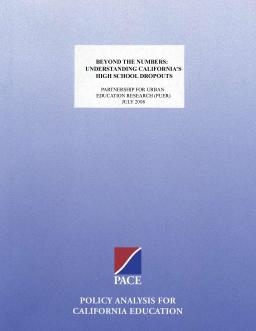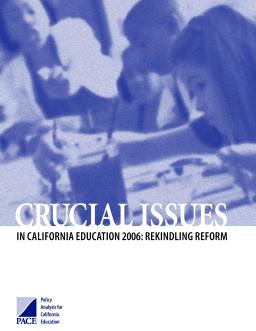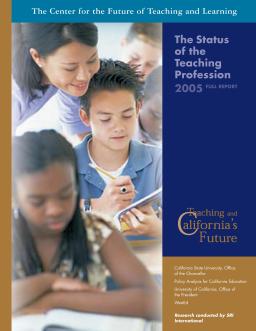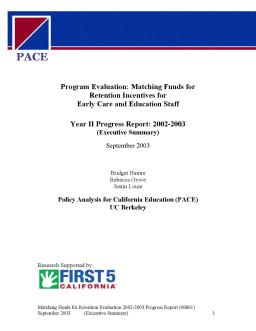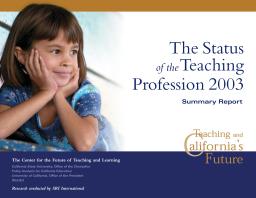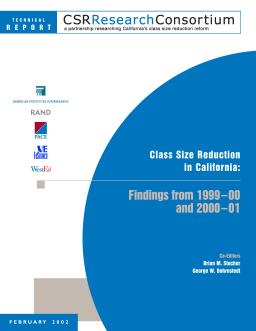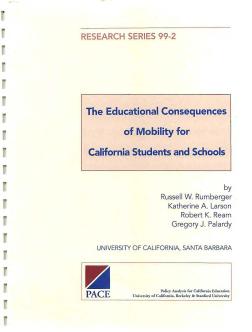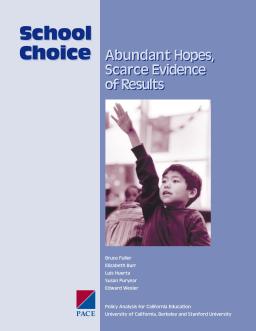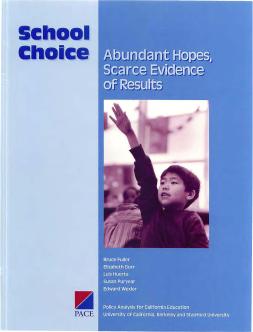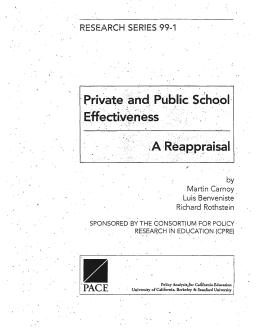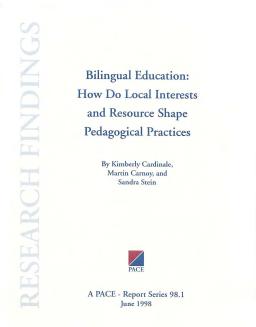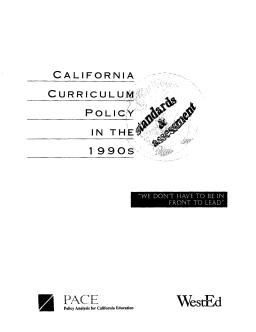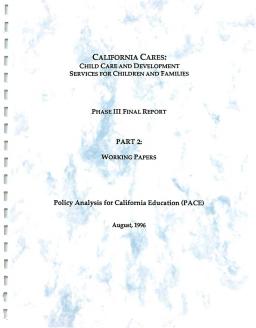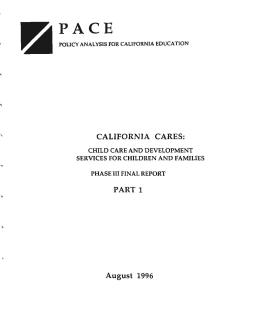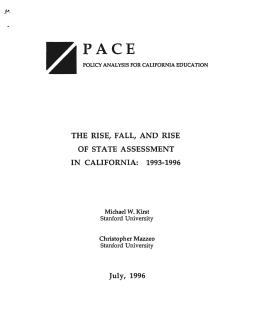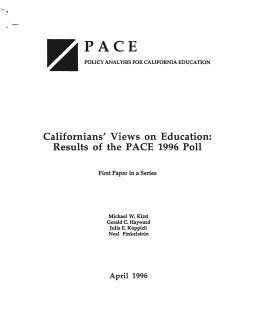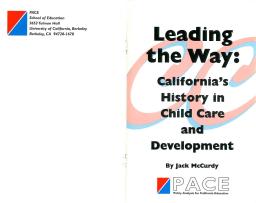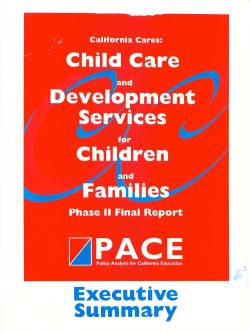Published
Summary
PACE is bringing back its publication, Conditions of Education in California, to keep the focus on the long-term education reforms required by California. Six policy scholars have contributed to this edition, providing baseline data on school performance and recommendations for policy changes to support long-term improvement. PACE plans to continue regular publication of this report to track progress towards a more effective educational system in California.
Understanding California's High School Dropouts
Published
Summary
The Partnership for Urban Education Research (PUER) comprises six of California's largest urban school districts working together to increase data availability, enhance internal research capacity, and promote collaboration and information sharing across district lines to benefit students. In a new report, PUER districts identified opportunities to improve the current dropout reporting system and reviewed district efforts to reduce dropout rates. PUER is working with PACE to review and publish their research.
Rekindling Reform
Published
Summary
This report discusses key education policy challenges in California, including funding, teacher quality, achievement gaps, and school accountability. The report highlights the need for equitable funding and effective teacher training and retention programs to address these issues. It also emphasizes the importance of holding schools accountable for student achievement and providing targeted support to struggling schools. The report concludes by calling for sustained attention to these critical education issues to ensure that all California students have access to a high-quality education.
Full Report
Published
Summary
The Teaching and California's Future initiative provides policymakers with data on the teacher workforce and labor market. The initiative's annual report details teacher development policies and their impact on teacher quality and distribution. The goal is to help policymakers make informed decisions about strengthening the state's teacher workforce.
Published
Summary
The quality of teaching and the need to expand California's ranks of excellent teachers demand urgent public discussion. We must attract the best and brightest to teaching, prepare them effectively, and support and retain them. Solutions require bipartisan leadership, not spin. This report presents the latest research and projections, highlighting that while some numbers are improving, we're likely to face severe shortages again soon and the pipeline for recruiting, preparing, and training teachers has substantial problems.
California’s Teaching Force, 2004—Key Issues and Trends
Published
Summary
California's aging teacher workforce will lead to a significant demand for teachers, with shortages particularly in special education and secondary education. The number of underprepared teachers in low-performing schools serving minority, poor, and ELL students is disproportionate. Budget cuts have reduced funding for recruitment and professional development programs, and California's induction system needs refinement. Curriculum-based professional development programs have mainly targeted elementary school teachers, neglecting the training needs of secondary teachers.
Year Two Progress Report, 2002–03—Executive Summary
Published
Summary
This report highlights findings from a 2002-03 progress report on First 5 California's childcare retention incentive programs, aimed at improving retention and increasing training among early care and education staff. Data were collected from ten counties through a phone survey of participants and site visits. Initial findings related to program design and implementation, program participation, training and professional development, and retention are summarized.
Summary Report
Published
Summary
This report argues that the state of California needs to prioritize better education for all children with a sustained long-term investment of resources and leadership. Despite political upheaval and fiscal problems, there is a consensus for better education. The authors suggest that the issue requires a response as intense and sustained as the state's response to natural disasters, and calls for a system of teacher development to ensure all teachers have the necessary knowledge and skills to meet academic standards.
Published
Summary
This report discusses the implementation and impact of class size reduction in California's K-3 classrooms. The initiative was prompted by concerns over falling standardized test scores in the mid-1990s. The report includes findings from a consortium of evaluators, including PACE, and provides policy recommendations and lessons learned.
Year 1—Qualitative Implementation Study
Published
Summary
This report provides guidance on implementing childcare retention initiatives based on Alameda County’s Child Development Corps program. PACE conducted focus groups with stakeholders to gather feedback on the planning and implementation process. The program saw increased commitment from providers to their profession and seeking training opportunities, but challenges remain with fitting permit requirements to family providers and relevance of courses.
Findings from 1999–2000 and 2000–01
Published
Summary
This report evaluates California's Class Size Reduction (CSR) program up to the 2000-01 school year, updating previous findings on teacher qualifications, curriculum, student achievement, and special populations. The report also discusses how districts and schools have allocated resources in support of CSR.
New Education Policies
Published
Summary
Senior slump is a phenomenon unique to American high schools, where students view senior year as a time for nonacademic pursuits. This report suggests curtailing senior slump to add valuable months to students' education at a critical point in their intellectual development. Policy directives are presented to help American high schools reclaim the senior year.
Published
Summary
Student mobility, or non-promotional school changes, is a widespread problem that harms students' educational achievement. This report examines the incidence, consequences, and causes of mobility among California students and schools, drawing on surveys of students, parents, and schools, interviews with mobile students and their parents, and interviews with school administrators, counselors, and teachers. The report summarizes the findings on the causes and consequences of mobility and offers strategies for reducing needless mobility and mitigating its harmful effects.
Abundant Hopes, Scarce Evidence of Results—Executive Summary
Published
Summary
Public education in the US is widely criticized and everyone wants to reform it, but there's no consensus on the best strategy for improvement. This report focuses on school choice, a reform avenue gaining steam in California and the US, to explore policies and institutional changes that can boost children's learning.
Abundant Hopes, Scarce Evidence of Results
Published
Summary
Public education receives criticism from various stakeholders. Despite satisfaction with local elementary schools, overall quality concerns prevail. There is no consensus on the best approach to improve schools. PACE report investigates school choice, which is a reform strategy gaining popularity in California and beyond.
A Reappraisal
Published
Summary
This report challenges the belief that public schools are ineffective due to a lack of accountability for producing high academic achievement. Some argue that private management is necessary for improvement, but this report seeks to analyze the range of responses that schools have to accountability and determine whether market forces are necessary for improvement.
How Do Local Interests and Resources Shape Pedagogical Practices?
Published
Summary
Bilingual education implementation varies by district due to discourse and policies. Four issues affecting implementation are teacher recruitment, "ghettoization" of bilingual education, race relations, and community consensus. National debates impact local administrative actions, defining bilingual education practice. The report analyzed four California school districts to show the impact of these four issues on program design.
California Families Face Gaps in Preschool and Child Care Availability
Published
Summary
This report highlights the unequal distribution of preschool and childcare opportunities in California. Despite spending $1.2 billion annually, half of preschool-age children live in households with working mothers, with enrollment dependent on income and location. Counties vary greatly in their supply, with affluent parents more likely to find preschool or childcare slots. Latino children are hit hardest, even in counties with ample supply, with supply in predominantly Latino areas half that of low-income Black or Anglo communities.
Standards and Assessments
Published
Summary
This study traces California's curriculum-related reforms in mathematics and science during the 1990s, examining the role of the California Department of Education and the state's shifting political and policy context. It analyzes the perceptions of state officials, experts, and the public and how they influenced state policy changes. The authors raise questions about problems associated with curriculum policy in California and presents policy recommendations mentioned during interviews and document analysis. The study does not assess the impact of curriculum on school practice.
Child Care and Development Services for Children and Families—Phase III Final Report, Part 2
Published
Summary
Phase III of the California Cares report sought to analyze preliminary recommendations and involve the childcare and development community to redesign policies. Work groups and field representatives discussed proposals for improving services, with over 80 contributors. The project studied nine critical policy restructuring questions and Part Two of the report includes reports from eight tasks and summary information.
Child Care and Development Services for Children and Families—Phase III Final Report, Part 1
Published
Summary
Phase III of the California Cares report aimed to redesign childcare and development policy, with input from the community and representatives from three agencies. Work groups and traditional research projects were conducted to study nine questions deemed critical to policy restructuring. Part II of the report includes working papers for all tasks except state governance, which is included in Phase III.
1993–96
Published
Summary
The California Learning Assessment System (CLAS) was created in 1991 to replace its predecessor and align California's testing system with state curricular frameworks, measure attainment of content through performance-based assessment, and provide individual student assessment. However, objections from various groups led to its discontinuation. CLAS serves as an example of the difficulties in implementing authentic forms of assessment and the politics involved in testing policy reform in the United States.
Results of the PACE 1996 Poll
Published
Summary
A 1996 statewide poll by PACE surveyed Californians on their views and expectations for public schools, informing policy discussions. Results revealed four broad themes and their relevance to ongoing education policy discussions, such as redesigning statewide assessments, reforming traditional school governance, providing public funds for private schools, and complex issues of local control. PACE believes public perceptions should be considered in policy discussions, although education policy should not be solely based on public opinion polls.
California's History in Child Care and Development
Published
Summary
New curriculum manuals have been created to address the expanding field of school-age childcare, including Kids' Time: A School-Age Care Program Guide. Other widely-recognized materials include Just Kids, Preparing for Mass Disasters, and A Guide for Training and Recruiting Child Care Providers to Serve Young Children with Disabilities. The benefits of childcare include fully-employed parents, self-sufficient families, and children who succeed in school due to the aid of childcare programs. Reducing Exceptional Stress and Trauma, a guide on coping with violence, will be published this year.
Child Care and Development Services for Children and Families—Phase II Final Report Executive Summary
Published
Summary
The California Cares Project, conducted by PACE for the California Department of Education, Social Services & Office of Child Development & Education, culminates in this report. The project was initiated in response to AB 2184, which sought to consolidate all childcare and development programs to streamline the system. The report is divided into two parts: Part I analyzes current obstacles to a seamless system and Part II presents a conceptual model and decision procedure for program and funding allocation and governance. Phase III will refine recommendations and work towards implementation.

